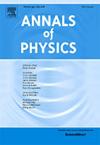The entropy of disorder fields in Euclidean Schwarzschild black hole
IF 3
3区 物理与天体物理
Q2 PHYSICS, MULTIDISCIPLINARY
引用次数: 0
Abstract
In the Euclidean Section of the Schwarzschild manifold, we discuss the generalized entropy of a black hole. We consider an Euclidean quantum scalar effective field theory with additive quenched disorder. Using the distributional zeta-function method, a series representation of the average of the Gibbs free energy over the ensemble of possible configurations of the disorder is obtained. In this series representation, the effective actions give rise to generalized Schrödinger operators on Riemannian manifolds. Each term of the series is a ratio between the determinant of the Laplace–Beltrami operator (plus the mass term) and the aforementioned Schrödinger operators. This ratio represents how the geometry and the disorder fields are interacting to modify the thermodynamic properties of the system, and the modification of the fluctuations introduced by the disorder. The obtained structure allows to construct an entropy which explicitly shows how the introduction of an additive disorder field affects the thermodynamic properties of the black hole. The disorder field is interpreted as an effective model for unknown degrees of freedom near the event horizon. Finally, is presented the generalized entropy density with the contributions of the black hole geometric entropy, external matter and disorder fields, and the validity of the generalized second law is demonstrated.
欧氏史瓦西黑洞中无序场的熵
在史瓦西流形的欧氏截面上,我们讨论了黑洞的广义熵。考虑具有加性猝灭失序的欧几里得量子标量有效场理论。利用分布ζ函数方法,得到了吉布斯自由能在各种可能构型综上的平均值的级数表示。在这个级数表示中,有效作用产生黎曼流形上的广义Schrödinger算子。级数的每一项都是拉普拉斯-贝尔特拉米算子的行列式(加上质量项)和前面提到的Schrödinger算子的比值。该比率表示几何和无序场如何相互作用以改变系统的热力学性质,以及由无序引入的波动的修改。所得到的结构允许构造一个熵,它明确地表明了加性无序场的引入如何影响黑洞的热力学性质。将失序场解释为视界附近未知自由度的有效模型。最后给出了考虑黑洞几何熵、外部物质和无序场贡献的广义熵密度,并证明了广义第二定律的有效性。
本文章由计算机程序翻译,如有差异,请以英文原文为准。
求助全文
约1分钟内获得全文
求助全文
来源期刊

Annals of Physics
物理-物理:综合
CiteScore
5.30
自引率
3.30%
发文量
211
审稿时长
47 days
期刊介绍:
Annals of Physics presents original work in all areas of basic theoretic physics research. Ideas are developed and fully explored, and thorough treatment is given to first principles and ultimate applications. Annals of Physics emphasizes clarity and intelligibility in the articles it publishes, thus making them as accessible as possible. Readers familiar with recent developments in the field are provided with sufficient detail and background to follow the arguments and understand their significance.
The Editors of the journal cover all fields of theoretical physics. Articles published in the journal are typically longer than 20 pages.
 求助内容:
求助内容: 应助结果提醒方式:
应助结果提醒方式:


